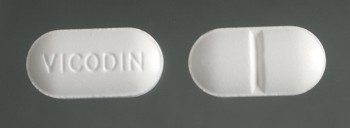The fictional “Nurse Jackie,” in the Showtime series of the same name, is a very competent nurse in a busy emergency room.
She’s also addicted to prescription painkillers: Percocet, Vicodin, OxyContin.
This portrayal of addiction is jarring, but it’s not wildly unrealistic.
Drug abuse among people in the health professions is reportedly about at the same level as among the general population. And abuse of painkillers, the specific problem depicted on the program, is rampant, reaching all segments of U.S. society.
Last week, the FDA recommended tighter controls on how doctors prescribe the most commonly used narcotic painkillers.
The move follows a long debate over whether the drugs, which contain the narcotic hydrocodone, should be controlled as tightly as more powerful painkillers such as OxyContin.
The drugs at issue contain a combination of hydrocodone and an over-the-counter painkiller like acetaminophen or aspirin and are sold either as generics or under brand names like Vicodin or Lortab.
Rick Allen, director of the Georgia Drugs and Narcotics Agency, said Monday that he believes the switch could help decrease overdoses and addictions to painkillers.
Hydrocodone “is probably the No. 1 forged prescription,’’ Allen said. New rules could help keep “so many large quantities out of the hands of patients,’’ he added. “It’s a pretty big problem.’’
Nationally, sales of prescription painkillers per capita have quadrupled since 1999 — and the number of fatal poisonings due to prescription painkillers has also quadrupled.
The FDA-recommended change would restrict the number of medical personnel authorized to prescribe the drugs. They would also require a patient to physically bring such a prescription to a pharmacy (as opposed to letting a doctor call in the prescription), and they would allow fewer refills before the patient is required to get another prescription.
Dr. Janet Woodcock, director of the FDA’s center for drug evaluation and research, said last week that she expected the new regulations could take effect as early as next year.
The recommendation requires the approval of the Department of Health and Human Services and adoption by the Drug Enforcement Administration, which has been pushing for the measure, the New York Times reported.
A Trust for America’s Health report released this month says the number of drug overdose deaths — a majority of which are from prescription medicines, not street drugs — doubled in 29 states since 1999. The rates quadrupled in four of these states and tripled in 10 more of these states.
Georgia was one of the states that saw these overdose deaths triple. The state ranks as the 36th-highest state for those deaths, with 10.7 per 100,000 people suffering fatal drug overdoses.
Prescription drug-related deaths now outnumber those from heroin and cocaine combined, and drug overdose deaths exceed motor vehicle-related deaths in 29 states and Washington, D.C., the report said. Misuse and abuse of prescription drugs cost the country an estimated $53.4 billion a year in lost productivity, medical costs and criminal justice costs.
In 2011, about 131 million prescriptions for hydrocodone-containing
The Trust for America’s Health report looked at 10 strategies that public health officials believe can be effective in reducing prescription-drug abuse, such as requiring a physician to conduct a physical exam and/or screening for drug abuse before prescribing prescription medications.
Georgia is pursuing six of the strategies, including having a prescription drug monitoring program, the report said. Meanwhile, a newly enacted law aims to help the state crack down on unscrupulous pain clinics known as “pill mills” that supply prescription narcotics to addicted patients.
Some see an overreaction
The FDA recommendation involves the reclassification of painkillers containing hydrocodone as “Schedule II” medications, from their current classification as “Schedule III” drugs. The scheduling system, which is overseen by the DEA, classifies drugs based on their medical use and their potential for abuse and addiction.
“When you wonder why your dentist gives you 40 hydrocodone for a toothache, or your knee doctor prescribes far more than he should, that’s because they’re under the impression that it’s not addictive as Percocet,” Dr. Andrew Kolodny, president of Physicians for Responsible Opioid Prescribing, told CNN in January when an FDA advisory panel first urged the administration to recommend tighter restrictions.
That somewhat benign view of hydrocodone is “completely false,” Kolodny said.
Pain specialists and their patients have been fighting the FDA move, saying any new restrictions on prescriptions would make it too difficult for those suffering from chronic, debilitating pain to get the drugs they need to survive, NPR reported recently.
The FDA acknowledged there is a debate, saying the agency “has been challenged with determining how to balance the need to ensure continued access to those patients who rely on continuous pain relief while addressing the ongoing concerns about abuse and misuse.’’
Both the Medical Association of Georgia and the Georgia chapter of the American College of Physicians said Monday that they did not have a position on the FDA recommendation.

